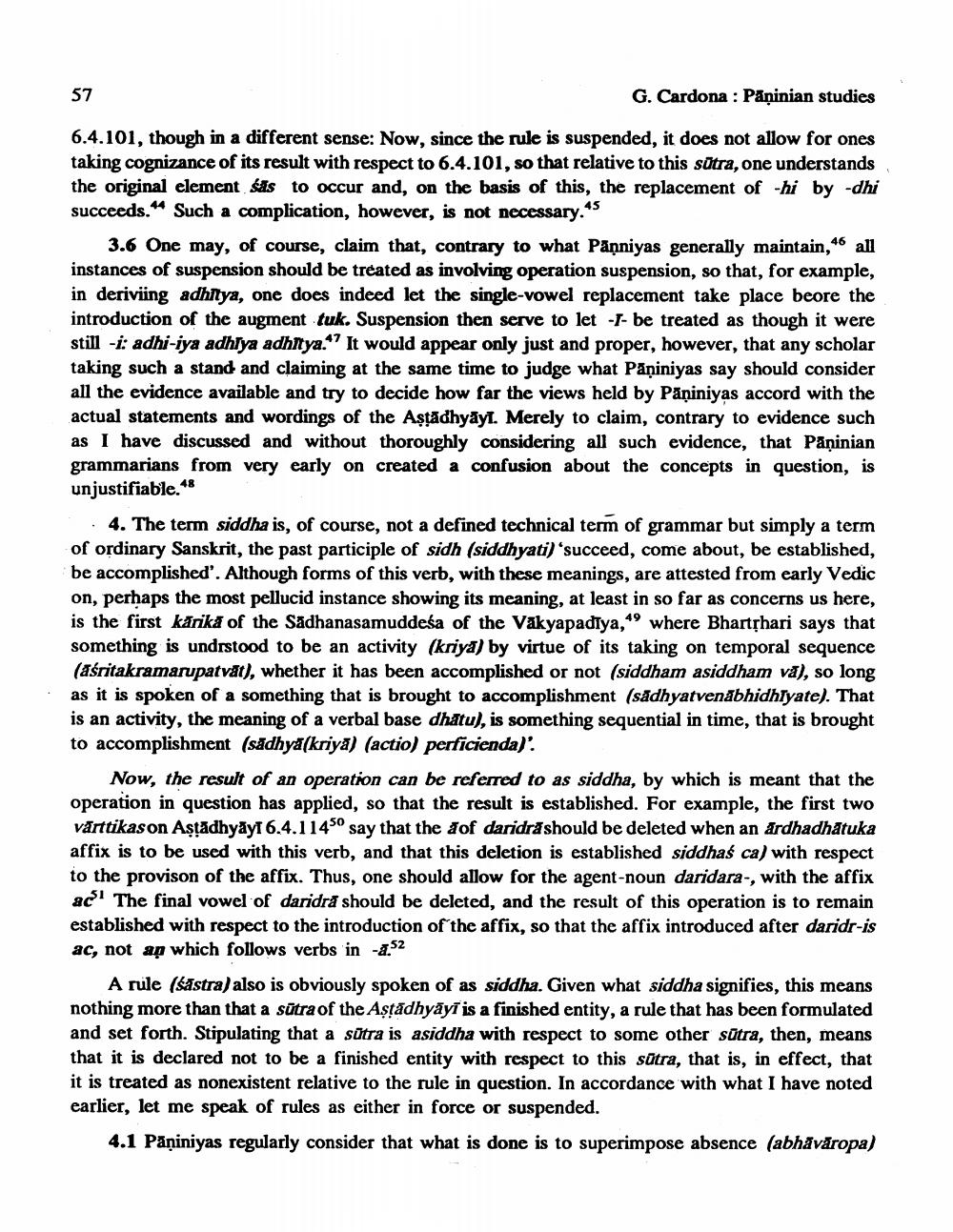________________
57
G. Cardona : Paņinian studies
48
6.4.101, though in a different sense: Now, since the rule is suspended, it does not allow for ones taking cognizance of its result with respect to 6.4.101, so that relative to this sūtra, one understands the original element śás to occur and, on the basis of this, the replacement of -hi by -dhi succeeds. Such a complication, however, is not necessary. "S
3.6 One may, of course, claim that, contrary to what Pāņniyas generally maintain, 46 all instances of suspension should be treated as involving operation suspension, so that, for example, in deriviing adhitya, one does indeed let the single-vowel replacement take place beore the introduction of the augment tuk. Suspension then serve to let -I- be treated as though it were still -i: adhi-iya adhfya adhitya."? It would appear only just and proper, however, that any scholar taking such a stand and claiming at the same time to judge what Pāṇiniyas say should consider all the evidence available and try to decide how far the views held by Pāņiniyas accord with the actual statements and wordings of the Astādhyāyt. Merely to claim, contrary to evidence such as I have discussed and without thoroughly considering all such evidence, that Pāņinian grammarians from very early on created a confusion about the concepts in question, is unjustifiable.48
• 4. The term siddha is, of course, not a defined technical term of grammar but simply a term of ordinary Sanskrit, the past participle of sidh (siddhyati) 'succeed, come about, be established, be accomplished'. Although forms of this verb, with these meanings, are attested from early Vedic on, perhaps the most pellucid instance showing its meaning, at least in so far as concerns us here, is the first kärikä of the Sadhanasamuddeśa of the Vakyapadiya,"9 where BhartȚhari says that something is undrstood to be an activity (kriya) by virtue of its taking on temporal sequence (aśritakramarupatvat), whether it has been accomplished or not (siddham asiddham vă), so long as it is spoken of a something that is brought to accomplishment (sådhyatvenābhidhsyate). That is an activity, the meaning of a verbal base dhātu), is something sequential in time, that is brought to accomplishment (sādhya(kriya) (actio) perficienda)'.
Now, the result of an operation can be referred to as siddha, by which is meant that the operation in question has applied, so that the result is established. For example, the first two värttikason Astādhyāyt 6.4.11450 say that the sof daridrashould be deleted when an ardhadhatuka affix is to be used with this verb, and that this deletion is established siddhaś ca) with respect to the provison of the affix. Thus, one should allow for the agent-noun daridara-, with the affix ad! The final vowel of daridrá should be deleted, and the result of this operation is to remain established with respect to the introduction of the affix, so that the affix introduced after daridr-is ac, not ap which follows verbs in -2.52
A rule (sastra) also is obviously spoken of as siddha. Given what siddha signifies, this means nothing more than that a sütra of the Astādhyāyī is a finished entity, a rule that has been formulated and set forth. Stipulating that a sūtra is asiddha with respect to some other sūtra, then, means that it is declared not to be a finished entity with respect to this sūtra, that is, in effect, that it is treated as nonexistent relative to the rule in question. In accordance with what I have noted earlier, let me speak of rules as either in force or suspended.
4.1 Pāṇiniyas regularly consider that what is done is to superimpose absence (abhåvaropa)




